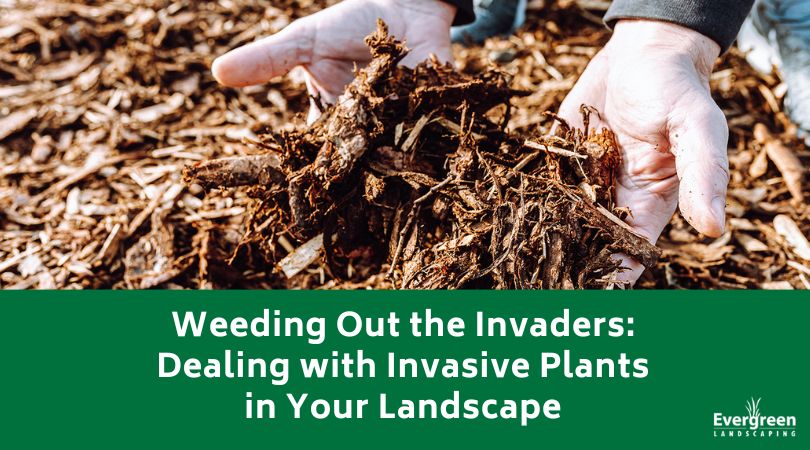
Invasive plants, the sneaky disruptors of our gardens, pose a significant threat to local ecosystems and native species. Their unchecked growth endangers biodiversity, demanding urgent action from gardeners and nature enthusiasts alike. In this blog, we dive into the world of invasive plants, focusing on their identification, the challenges in managing them, and effective solutions. Imagine this as your guidebook to restoring balance in your garden. By understanding these invaders and implementing the strategies shared here, you not only protect your garden’s vibrancy but also play a crucial role in preserving the natural harmony of our local ecosystems.
Identifying Common Invasive Plant Species in San Luis Obispo
Let’s acquaint ourselves with the garden troublemakers in San Luis Obispo. First up, the Japanese Knotweed, characterized by its bamboo-like stems, heart-shaped leaves, and clusters of small white flowers. This invasive plant spreads rapidly, outcompeting native vegetation and destabilizing soil with its robust root system.
Next on our list is Kudzu, often dubbed “the vine that ate the South.” Recognizable by its large, green leaves and fast-growing vines, Kudzu engulfs everything in its path, smothering trees, shrubs, and buildings under a blanket of green.
Lastly, meet English Ivy, an evergreen climbing vine with glossy, lobed leaves. While it might seem charming, this plant is a formidable invader. Its creeping tendrils infiltrate gardens, smothering the ground and climbing structures, disrupting native plant habitats and eroding the natural biodiversity.
By recognizing these invasive species through their distinct characteristics, you can proactively protect your landscape. Stay vigilant and take action against their encroachment to preserve San Luis Obispo’s natural beauty!
Expert Tips on Effective Removal of Invasive Plants
Ready to reclaim your garden from invasive intruders? Let’s dive into expert removal strategies tailored for these stubborn invaders. When dealing with these plants, understanding their root systems and the extent of their infestation is crucial.
Manual removal stands as a stalwart method. Equip yourself with sturdy gloves, a trusty shovel, and perhaps a sharp pruning saw for the more tenacious foes. Focus on complete extraction, ensuring no remnants are left behind. Proper disposal is key; prevent regrowth by safely disposing of plant materials, ensuring they don’t find their way back into your garden.
But here’s the eco-friendly twist: skip the harmful herbicides. Embrace alternatives like natural mulches or targeted grazing by animals that consume these invasives. These methods are not only effective but also gentle on your garden’s ecosystem.
Prevention and Long-Term Management Strategies
In the quest to keep invasive plants at bay, understanding the tools at your disposal is key. Let’s delve deeper into two powerful allies: dense plantings and mulching.
Dense Plantings: Think of your garden as a crowded city, bustling with inhabitants. Dense plantings involve strategically placing plants close together, leaving minimal gaps between them. This approach creates a lush, interconnected green landscape where plants act as natural bodyguards, crowding out any potential invader. With limited space and resources, invasive plants struggle to establish themselves amidst the tight-knit community of your garden, ensuring their encroachment is thwarted.
Mulching: Picture mulch as a protective cloak for your garden soil. Mulching involves spreading a layer of organic or inorganic material (such as wood chips, straw, or gravel) around the base of plants. This layer acts as a formidable barrier, suppressing weed growth, conserving soil moisture, and regulating soil temperature. In the context of invasive plants, mulch becomes your garden’s shield. By forming a physical barrier, it hinders the growth of invasive seeds and prevents their establishment. Additionally, mulch enriches the soil as it breaks down, promoting a healthier environment for your desirable plants to thrive.
But the true guardians of your garden’s sovereignty are regular maintenance and keen observation. Regularly inspect your green domain, identifying any suspicious growths early. At the first sign of invasion, swift removal is your best strategy.
Choosing Native or Non-Invasive Plant Alternatives
When it comes to selecting the green citizens of your garden, choosing wisely is paramount. Native plants and non-invasive species emerge as the heroes of this narrative, preserving the delicate balance of your local ecosystem.
Native Plants: Picture native plants as the true inhabitants of your region, perfectly adapted to its climate and soil. By welcoming them into your garden, you’re not just enhancing its beauty; you’re promoting biodiversity and offering vital support to local wildlife. These plants provide natural habitats and food sources, ensuring a harmonious coexistence between your garden and the creatures that call it home. Whether you’re in a sunny or shady spot, there’s a native plant suited for your specific climate and region, each one contributing to the vibrant tapestry of your local environment.
Non-Invasive Ornamental Plants: Now, consider non-invasive ornamental plants as the charming guests of your garden. These beauties not only require minimal maintenance but also elevate the aesthetic appeal of your landscape. Their ability to dazzle without overpowering makes them ideal candidates for enhancing your garden’s visual allure. Imagine vibrant blooms, lush foliage, and delicate scents adorning your space, all without the worry of invasive tendencies.
By opting for native plants or non-invasive ornamental species, you’re making a conscious choice to preserve the natural integrity of your region while adorning your garden with enduring beauty.
As you embark on your gardening journey, armed with the expert tips and strategies shared here, you’re equipped to create a haven of natural beauty and ecological responsibility. Let these insights be your guiding light, empowering you to make mindful decisions, embrace sustainable practices, and cultivate a garden that not only flourishes aesthetically but also thrives in harmony with the intricate web of life.
Ready to transform your garden into a sanctuary of ecological balance and stunning aesthetics? Contact Evergreen Landscaping today. Our skilled team is here to assist you, ensuring your garden not only blooms but thrives, harmonizing with nature’s rhythm. Let’s cultivate a garden that stands as a testament to the splendor of the natural world!
